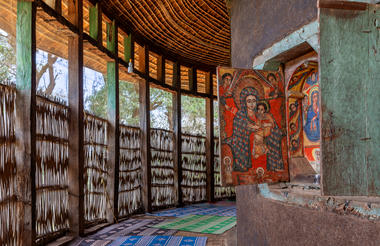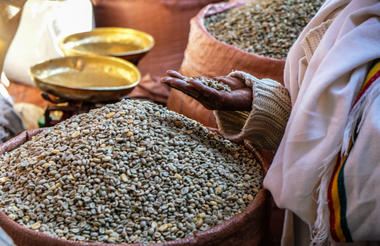Situated in the Horn of Africa, Ethiopia boasts extraordinary natural features, a vast range of wildlife, and a captivating historical and cultural heritage. An increasing number of visitors frequent this treasure trove filled with unique attractions. Popular attractions include the medieval castles of Gondar, the walled city of Harar, and Lalibela, a pilgrimage site known for its ancient monolithic churches hewn into the area’s steep rocky hillsides. Ethiopia’s stunning natural landscapes are the real tourist drawcard. From the lush Simien Mountains to the sulphur vents of the Danakil Depression, the country’s outstanding natural environment is unforgettable. Bahir Dar, located on Lake Tana, is popular as a base to explore the fascinating monasteries on the numerous islands dotted around the lake and the Blue Nile Falls, which are arguably the most spectacular falls in North Africa.
The world’s third-highest capital city, Addis Ababa - literally ‘New Flower – boasts a temperate climate and well-watered setting that defies popular expectations of Ethiopia. It was founded in the 1880s as the imperial capital of Menelik II and has served as headquarters of the African Union since 1963. Now a sprawling city of four million, Addis Ababa is the main air gateway to the country, and it combines a cosmopolitan outlook with a proudly Ethiopia sense of tradition.
Some excellent museums explore various facets of Ethiopia’s storied past. At one extreme, the National Museum documents a 5.5-million-year hominid fossil record that substantiates Ethiopia’s claim to be the Cradle of Humankind. At the other, the chilling Red Terror Martyrs’ Memorial Museum deals with the genocide committed under the Derg regime of 1975-91.
Addis Ababa is renowned for its ‘cultural restaurants’. Thatched in traditional tukul-style buildings, these serve a wide range of fiery meat and vegan Ethiopian dishes and host colorful music and dance performances that highlight the country’s incredible cultural diversity.
The city’s oldest functioning church, octagonal Entoto Maryam is where Emperor Menelik II was coronated in 1889. Emperor Haile Selassie was crowned in St George’s Cathedral in 1830 and is now buried in the Arabesque Trinity Cathedral.
Tiya Stelae Field is a UNESCO World Heritage Site whose 36 engraved megaliths were erected in the 13th century to mark mysterious mass graves of soldiers laid to rest in a fetal position. It can be visited as a day trip out of Addis Ababa in conjunction with the rock-hewn church of Adadi Maryam.
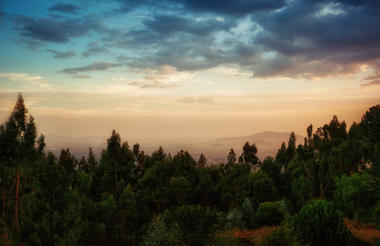

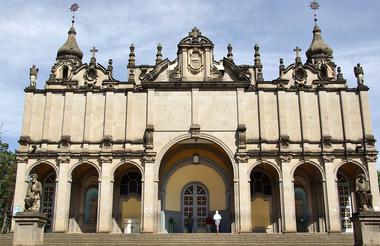
The ancient city of Axum served as the capital of an empire that dominated the Red Sea trade for centuries prior to the rise of Islam. Unverified legend has it that the city was founded 3,000 years ago by Emperor Menelik I, an illegitimate son of the Queen of Sheba and King Solomon, and it is almost certainly the oldest continuously-inhabited city anywhere in sub-Saharan Africa. Now a UNESCO World Heritage Site, it is a fascinating place to explore with its wealth of ancient obelisks, catacombs, palaces, churches, and other such artifacts.
Axum’s famous Stelae Park is dominated by a trio of gigantic engraved granite megaliths erected in the 4th century or earlier. The tallest of these megaliths would have towered 108ft high but it now lies shattered on the ground. The tallest standing stele is 82ft high, comparable to a 10-story building.
Tsion Maryam (Mary of Zion) is the country’s oldest church. The foundations of the original church established by King Ezana in 341 A.D. are still visible alongside a handsome stone replacement built by King Fasil of Gondar in the 17th century. Legend has it that the Ark of the Covenant is locked away in a guarded church outbuilding.
Key sites on the outskirts of Axum include Dongar Palace, which legend associates with the Queen of Sheba, and the tombs of the 6th-century emperors Kaleb and Gebre Meskel.
Easily visited on a day trip from Axum, the 40ft-high sacrificial temple at Yeha is Ethiopia’s most ancient standing structure, dating back 2,700 years.
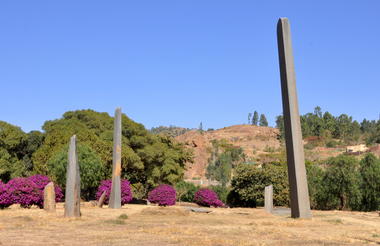
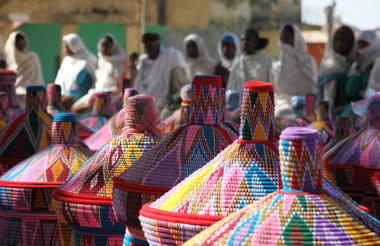
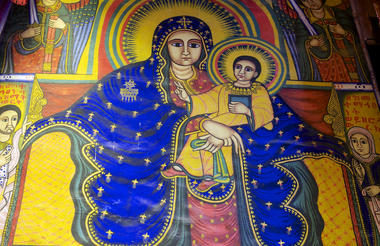
The most inspirational historical site in sub-Saharan Africa, the small highland village of Lalibela houses a medieval complex of 13 churches and chapels that were hand-carved into the bedrock in the 12th century under the direction of King Lalibela. The apex of Ethiopia’s ancient church-excavating architectural tradition, this UNESCO World Heritage Site is also remarkable in that it remains an active Christian more than 800 years ago since its inception.
Almost entirely subterranean, Lalibela’s northern cluster of seven churches and chapels possesses an architectural cohesion that suggests it was conceived as one entity. It incorporates Bet Medhane Alem, which is the world's largest rock-hewn monolith, supported by 36 internal and 36 external pillars.
The five architecturally divergent churches that comprise the southern cluster are thought to have been converted from older secular excavations. The cluster includes Bet Gebriel-Rafael, an imposing fortress-like excavation enclosed by a deep dry moat
Lalibela’s most photogenic church, standalone Bet Giyorgis is an asymmetrical cross-shaped monolith enclosed by a 50ft-deep hand-carved trench. It is dedicated to Saint George, whose horse reputedly made the hoof-like marks that can be seen in the entrance walkway today.
Easily visited as a day trip from Lalibela, the 11th-century church of Yemrehanna Kristos, constructed with alternating layers of wood and white gypsum, is one of the finest surviving examples of traditional Axumite architecture.
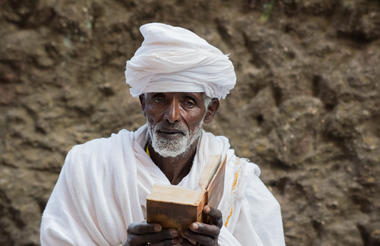
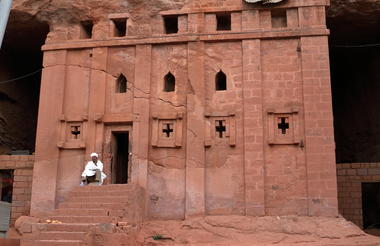
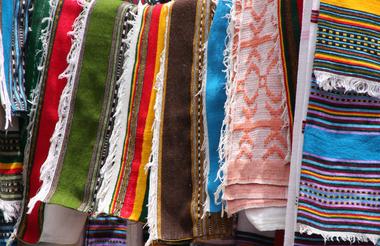
Ethiopia’s top hiking destination, Simien Mountains National Park protects Africa’s fifth-highest mountain range: a stupendous glacially-incised landscape of precipitous canyons, jagged peaks and undulating Afroalpine moorland. Inscribed as a UNESCO World Heritage Site, the park protects a wealth of rare wildlife, from the charismatic gelada monkey to the magnificent bearded vulture.
The spectacular uplands of the Simiens are best explored on foot. A good hiking route for scenery and wildlife is a 3-day trail connecting Sankaber to Ayna Meda. For serious peak-baggers, the 14,872ft Ras Dejen is the highest point in Ethiopia.
Less active or time-restricted travelers can get a good feel for the park’s scenery and wildlife by driving along the high-altitude all-weather road that bisects it in an easterly direction.
Endemic to Ethiopia, the gelada monkey is notable for its complex harem-based social structure and the male’s flowing golden mane and red heart-shaped chest-patch. Immersing yourself in a habituated troop of these monkeys as they forage, squabble and play on the highland meadows of the Simiens ranks among the world’s most exhilarating and underrated wildlife encounters
The Simiens provide refuge to the world’s last remaining 1,200 Walia ibex. The only goat indigenous to sub-Saharan Africa, the ibex is most often seen on narrow cliff edges, where its heavy decurved horns render it unmistakable.
The park’s checklist of 180 bird species includes several alluring heavyweights. These include the endemic thick-billed raven, which is the heaviest of the world’s 5,000 passerine species, and the magnificent lammergeyer (bearded vulture), a localized cliff-nesting raptor with a 6ft wingspan.
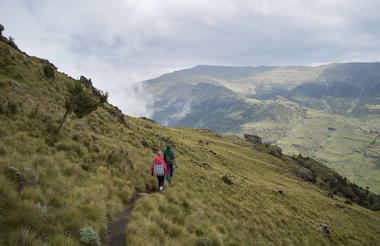
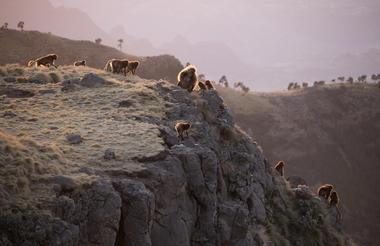
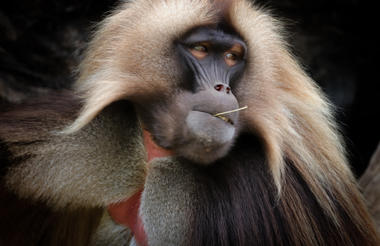
A former capital of Ethiopia, Gondar is nicknamed the Camelot of Africa in reference to its wealth of fairytale castles and churches dating from its 17th-century heyday. Protected as a UNESCO World Heritage Site, these architectural gems ensure the city is an important attraction in its own right. For many visitors, however, Gondar is of greater interest as the air gateway to Simien Mountains National Park, a popular hiking destination 60 miles to the north.
The central Fasil Ghebbi is a stone-wall Royal Compound containing six castles and three churches. The handsome three-story castle credited to Emperor Fasil, who founded the city in 1635, is the undisputed gem among these, and its blend of indigenous Axumite and imported Portuguese and Indian influences would come to define the Gondarine architectural style.
Also associated with the namesake king, Fasil’s Pool, a sunken quadrangle overlooked by a two-story stone building, is where Gondar’s colorful Timkat celebrations are held every January.
The most beautiful of Gondar’s churches, Debre Birhan Selassie (‘Mountain of the Enlightened Trinity’) is adorned with cartoon-like strips comprising hundreds of 17th-century ecclesiastic paintings, all set below a ceiling decorated with neat rows of cherubic faces.
For those who don’t have time to explore the Simien Mountains, guided day hikes at Wunenia, a short drive north of Gondar, offer an opportunity to see endemic wildlife in spectacular montane scenery.
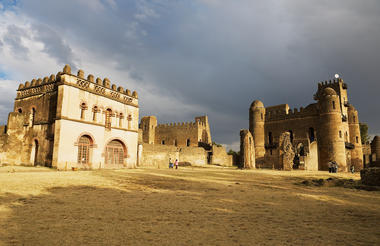
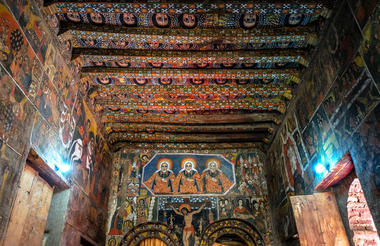
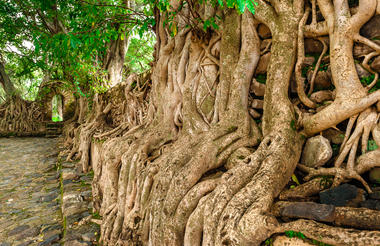
The lively modern city of Bahir Dar boasts a balmy tropical climate and a geographically poignant setting where the Blue Nile exits Lake Tana. It is the normal base for day trips to the spectacular Blue Bile Falls and for exploring Lake Tana, a beautiful 1,200-square-mile inland sea whose islands and peninsulas hosts a wealth of atmospheric old monasteries.
A great selection of restaurants and traditional music venues ensure that Bahir Dar is rivaled only by Addis Ababa when it comes to an enjoyable nightlife.
Listed as a UNESCO Biosphere Reserve, Lake Tana is renowned for its rich birdlife and it also hosts plenty of hippos. A good place to see these is Bezawit Hill on the outskirts of Bahir Dar.
The Blue Nile Falls, known locally as Tis Isat (Smoking Water), is most sensational in the rainy season when it kicks up a thunderous wall of spray as it crashes 150ft into a narrow frothing gorge. The footpath to the waterfall crosses a Portuguese bridge dating to 1626.
Among the most beautiful of Lake Tana’s medieval monasteries is Ura Kidane Mihret, with its lavishly painted interior and fabulous forested location on the Zege Peninsula.
Several other more remote island churches are worth a visit. Tana Chirkos hosts a trio of ancient Judaic sacrificial pillars that substantiate the claim it once housed the Ark of the Covenant, while the mausoleum on Daga Istafanos contains the mummified remains of five Ethiopian emperors.
